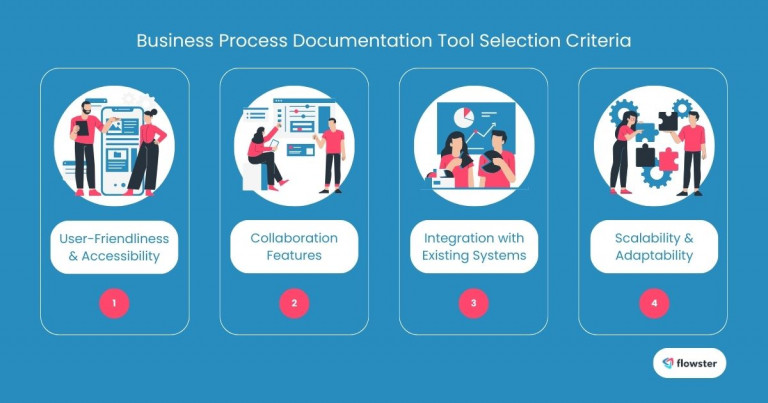In today’s fast-paced business environment, documenting processes is more crucial than ever. Whether you’re a small startup or a large corporation, having clear and organized documentation can significantly enhance efficiency and scalability. This is where tools for documenting business processes come into play.
These tools assist teams in capturing workflows, streamlining operations, and guaranteeing alignment among team members. In this guide, we’ll explore the best tools available in 2025, highlighting their features and benefits to help you choose the right one for your needs. Let’s dive in!
Article Outline
Importance of Documenting Business Processes
Documenting business processes is essential for any organization aiming to improve efficiency and maintain consistency. In this section, we’ll explore why documentation matters, focusing on its benefits for efficiency, onboarding, and compliance. Understanding these aspects will highlight the significance of utilizing tools for documenting business processes effectively.
Why Documentation Matters
Effective documentation serves as the backbone of any successful business operation. It allows organizations to streamline workflows and ensure that all team members are aligned in their tasks. By capturing processes clearly, businesses can reduce confusion and enhance overall productivity.
How Well-Documented Processes Facilitate Onboarding and Compliance
Facilitating Onboarding:
Well-documented processes simplify the onboarding experience for new employees. Clear guidelines and step-by-step instructions enable newcomers to quickly understand their roles and responsibilities. This reduces the time it takes for them to become productive team members.
Ensuring Compliance:
Documentation also plays a critical role in compliance with industry regulations. By having detailed records of processes, organizations can ensure that all employees are aware of the necessary guidelines and standards. This minimizes the risk of non-compliance, which can lead to fines or reputational damage.
In summary, documenting business processes is not just a task; it’s a strategic move that preserves organizational knowledge and fosters consistency. For more insights on how process documentation can benefit small businesses, check out this article: Business Process Management for Small Businesses.

Criteria for Choosing the Right Tools for Documenting Business Processes
Selecting the right tools for documenting business processes is crucial for maximizing efficiency and collaboration within your team. With a plethora of options available, it’s essential to evaluate certain criteria to ensure you choose a tool that meets your specific needs. In this section, we’ll discuss the key factors to consider when assessing tools for documenting business processes.
User-Friendliness and Accessibility
A user-friendly interface is vital for encouraging team adoption. If a tool is too complex or difficult to navigate, team members may shy away from using it. Look for documentation tools that offer intuitive controls, making it easy for everyone, regardless of technical skill, to contribute effectively.
Collaboration Features
Collaboration is at the heart of successful documentation. Tools that facilitate real-time collaboration and feedback allow teams to work together seamlessly. Features such as comments, version history, and shared access can significantly enhance teamwork and ensure that everyone stays informed about process updates.
Integration with Existing Systems
Consider how well the documentation tool integrates with your current tech stack. Smooth integration with other software—like CRM systems or project management tools—can streamline your workflows. The easier it is for the tool to fit into your existing processes, the more effective it will be in enhancing productivity.
Scalability and Adaptability
As your business grows, so will your documentation needs. Choose tools that are scalable and adaptable to changing requirements. A flexible tool can accommodate new processes and team members without requiring a complete overhaul of your documentation strategy.
In conclusion, taking the time to evaluate these criteria will help you find the best tools for documenting business processes tailored to your organization’s needs. For further insights on creating effective business process workflows, check out this article: 5 Steps to Create Business Process Workflows.
Flowster's AI-Driven Automation
Top Tools for Documenting Business Processes
The right tools can significantly impact business process documentation. With numerous options available in 2025, it’s essential to choose tools that not only fit your needs but also enhance collaboration and efficiency. In this section, we’ll explore some of the top tools for documenting business processes, highlighting their features and benefits.
1. Process Mapping Software
Lucidchart and Microsoft Visio are popular choices for process mapping. These tools allow users to create detailed diagrams that visually represent workflows. Key features include diagram creation, a variety of templates, and easy sharing options, making it simple for teams to collaborate and refine processes together.
2. Business Process Management (BPM) Tools
Bizagi and Nintex stand out as robust BPM tools designed for process automation and monitoring. They enable organizations to streamline workflows by automating repetitive tasks. With features like real-time analytics and process tracking, these tools help ensure that processes run smoothly and efficiently.
3. Documentation and Knowledge Management Systems
Confluence, Notion, and SharePoint are excellent for collaborative documentation. These platforms facilitate easy access to information, allowing teams to create, edit, and share documents seamlessly. Their ability to integrate with other tools enhances their functionality, making them ideal for maintaining comprehensive knowledge bases.
4. Workflow Automation Tools
Flowster and Monday.com are effective workflow automation tools that simplify process documentation. They allow users to automate tasks and manage workflows visually. This not only saves time but also reduces the likelihood of errors in documentation, ensuring consistency across processes.
5. Project Management Software
Tools like Asana and Trello can also serve as valuable resources for documenting processes within projects. They provide task tracking alongside process documentation, which helps teams stay organized and focused on their goals. The ability to visualize project milestones enhances overall project management.
In summary, selecting the right tools for documenting business processes can significantly impact your organization’s efficiency and collaboration. For more tips on updating your business processes effectively, check out this article: 6 Must-Know Tips for Updating Business Processes.
Capture Your Processes in Minutes!
How to Easily Document Business Processes
Documenting business processes doesn’t have to be a daunting task. With the right approach and tools, you can create effective documentation that enhances clarity and efficiency. In this section, we’ll explore how to easily document business processes using tools for documenting business processes, with a special focus on Flowster Capture.
Introduction to Flowster Capture
Flowster Capture is a screencasting extension designed to simplify the creation of standard operating procedures (SOPs) by recording your actions on the screen. This tool is particularly useful for documenting various processes, such as onboarding new employees or launching products. By capturing every click and keystroke, Flowster Capture makes it easier to follow the SOPs you create.
How Flowster Capture Works
- Start Recording: Click on the Flowster Capture extension to begin recording your workflow.
- Perform Your Steps: Carry out the steps involved in a specific process, like creating a new blog post. This includes giving it a title, categorizing it, choosing a featured image, and writing the content.
- Capture Every Action: Flowster Capture records every click and keystroke, highlighting where you interacted on the screen.
- Create Your Template: Once finished, you can copy the captured steps and paste them into a new template within the Flowster app.
- Organize Your Steps: Give the steps intuitive names, organize them with headings, and remove any unnecessary actions.
- Assign Workflows: After creating your template, run a workflow and assign it to someone on your team. They will see the documented steps and can check them off as they complete each task.
Overall, Flowster Capture is a time-saving tool that helps you create and share SOPs with ease. By utilizing such tools for documenting business processes, you can streamline your operations and enhance team collaboration.
To see Flowster Capture in action, be sure to watch this video:
Conclusion
In conclusion, effectively documenting business processes is essential for enhancing efficiency, ensuring compliance, and facilitating onboarding. By utilizing the right tools for documenting business processes, organizations can streamline their operations and maintain clarity across teams. The tools discussed in this guide offer various features tailored to meet diverse business needs, making it easier than ever to create comprehensive documentation.
As you embark on your journey to improve process documentation, consider exploring free SOP templates to get started quickly and efficiently. You can easily access these templates at Flowster Marketplace.




